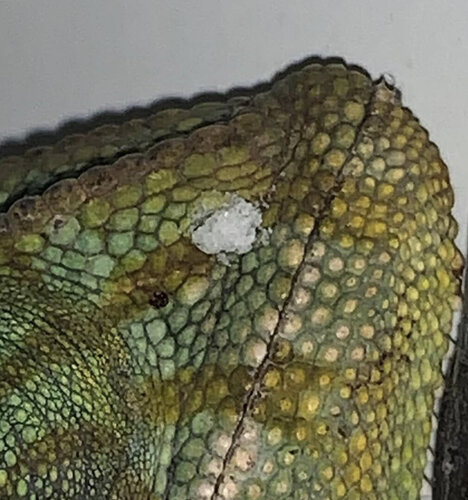Brodybreaux25
Chameleon Enthusiast
Credit: Petr Necas
SALT CRYSTALS AROUND NOSTRILS
Often, people ask questions about the white crystals around the nostrils...
What are the myths and what is true?
Myth 1: People believe it comes from tap water...
True:
In the wild, the most chameleons do not drink at all or drink rarely and minute amounts of water.
The most water intake is processed through breathing in fog at high air humidity at night.
If they drink at all, they drink dew and rainwater which technically is a distilled water free of minerals but: it gets polluted by dust in the air and on the leaves, so it is not purely mineral-free but almost.
If you provide lots of water for your chams to drink, it is unnatural and it will impact their wellness regardless whether you use tap water or reverse osmosis purified water or distilled water.
If you use minute amounts of water, there is also no problem, as the content of salt in the tapwater will be even more minute.
Myth 2: People believe it is something wong, a pathology
True:
It is totally physiological and normal. And nothing what we should be afraid of, on contrary, of it does not happen long-term, something is wrong!
Myth 3: People believe it is excess Calcium and even recommend to stop supplementing
True: It has nothing to do withe the metabolism of Calcium, the crystals consist basically of two chlorides, salts: NaCl and KCl.
To recommend to stop supplementation is harmful and never do so because of salt crystals around nostrils!
Myth 4: People simply do not knоw what it is, so they create various legends and myths...
True:
When Reptiles conquered the land, they have built an efficient barrier against water loss: the skin. It is impenetrable for water AND for salt.
Keeeping homeostasis, especially ballance of the electrolytes, is vital.
In this game, dominant role is played by the following elements: Cl (Chlorine), Na (Natrium) and K (Potassium).
These, also can not penetrate the skin. So, excessive amounts are exspelled by the body using Excretion, Urination and through the Salt gland: here in form of the two chlorides, salts: NaCl and KCl. The nasal salt gland is widely present in many reptiles.
@Putin_On_Me_Glasses
SALT CRYSTALS AROUND NOSTRILS
Often, people ask questions about the white crystals around the nostrils...
What are the myths and what is true?
Myth 1: People believe it comes from tap water...
True:
In the wild, the most chameleons do not drink at all or drink rarely and minute amounts of water.
The most water intake is processed through breathing in fog at high air humidity at night.
If they drink at all, they drink dew and rainwater which technically is a distilled water free of minerals but: it gets polluted by dust in the air and on the leaves, so it is not purely mineral-free but almost.
If you provide lots of water for your chams to drink, it is unnatural and it will impact their wellness regardless whether you use tap water or reverse osmosis purified water or distilled water.
If you use minute amounts of water, there is also no problem, as the content of salt in the tapwater will be even more minute.
Myth 2: People believe it is something wong, a pathology
True:
It is totally physiological and normal. And nothing what we should be afraid of, on contrary, of it does not happen long-term, something is wrong!
Myth 3: People believe it is excess Calcium and even recommend to stop supplementing
True: It has nothing to do withe the metabolism of Calcium, the crystals consist basically of two chlorides, salts: NaCl and KCl.
To recommend to stop supplementation is harmful and never do so because of salt crystals around nostrils!
Myth 4: People simply do not knоw what it is, so they create various legends and myths...
True:
When Reptiles conquered the land, they have built an efficient barrier against water loss: the skin. It is impenetrable for water AND for salt.
Keeeping homeostasis, especially ballance of the electrolytes, is vital.
In this game, dominant role is played by the following elements: Cl (Chlorine), Na (Natrium) and K (Potassium).
These, also can not penetrate the skin. So, excessive amounts are exspelled by the body using Excretion, Urination and through the Salt gland: here in form of the two chlorides, salts: NaCl and KCl. The nasal salt gland is widely present in many reptiles.
@Putin_On_Me_Glasses




